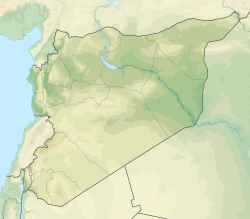Top Qs
Timeline
Chat
Perspective
Tell al-Hara
Highest point in the Daraa Governorate of Syria From Wikipedia, the free encyclopedia
Remove ads
Tell al-Ḥāra, formerly known as Ḥārith al-Jawlān or Jabal Ḥārith, is the highest point in the Daraa Governorate. During the Arab–Israeli conflict and the Syrian Civil War, it has served as a highly strategic military position because it overlooks wide areas of the Golan Heights and Hauran regions. The closest population center is the town of al-Hara, located at the hill's southeastern foot.
Remove ads
Description
Tell al-Hara is a conical-shaped tell (mound or hill) with an elevation of 1,127 meters (3,698 ft) above sea level.[1] Like the neighboring hills, Tell al-Hara belongs to the range of extinct volcanoes of the Jaydur region and a wide crater opens at its summit.[2] It is the highest point in the Daraa Governorate,[3] and overlooks the Hauran plain.[1]
At the southeastern foot of Tell al-Hara is the town of al-Hara.[4] Damascus is 50 kilometers north of Tell al-Hara, the governorate capital Daraa is 55 kilometers to the south, the district capital al-Sanamayn is 18 kilometers to the east and the Israeli-occupied Golan Heights is 12 kilometers to the west.[5][6] Near the southern foot of Tell al-Hara begins the Nahr al-Allan river,[7] which terminates near the border with Jordan.
Remove ads
Name
Tell al-Hara was known as "Jabal Ḥārith" in the late Byzantine era.[8] It was named after the Ghassanid king al-Harith and was referred to as "Ḥārith al-Jawlān" by the contemporary Arab poets al-Nabigha and Hassan ibn Thabit.[8] The modern name of the tell and the town at its foot, "al-Ḥāra", is a "mutilated" version of its Ghassanid name "al-Ḥārith", according to historian Irfan Shahîd.[8] The tomb of the Ghassanid king al-Nu'man ibn al-Harith was said to be located at the summit of Tell al-Hara by al-Nabigha, though the scholarly consensus places al-Nu'man's tomb in the village of al-Hara.[4]
Remove ads
History
Summarize
Perspective
In the 1890s, the German archaeologist Gottlieb Schumacher noted that the tomb of a certain Muslim saint, Umar al-Shahid, "crowned" Tell al-Hara.[2] He also noted that at the hill's western foot were the ruins of a Christian monastery known as Deir al-Saj, which he suspected was of Ghassanid origin.[2]
Following Israel's occupation of the Golan Heights in 1967, Tell al-Hara served as a strategic Syrian reconnaissance point overlooking the Golan Heights.[9] It was captured by Syrian rebel forces fighting under the banners of the Free Syrian Army (FSA) and Jabhat al-Nusra from the 7th Armored Division,[5] one of the largest armored brigades of the Syrian Arab Army (SAA) in southern Syria,[6] on 5 October 2015, partially as a result of the apparent defection of SAA general Mahmoud Abu Araj.[5] Tell al-Hara's capture paved the way for the rebels' capture of much of the western Daraa Governorate and the southern Quneitra Governorate.[3] They held Tell al-Hara for about four years until Syrian government forces retook control of the hill on 7 July 2018 after a two-day battle.[3] Rebels apparently recaptured it before surrendering the hill to government forces in a reconciliation agreement on 16 July.[6]
On 8 December 2024, after Israel launched an invasion of Syria amid the fall of the Assad regime, Al Arabiya reported that Israel had taken control of Tell al-Hara.[10][better source needed]
References
Bibliography
Wikiwand - on
Seamless Wikipedia browsing. On steroids.
Remove ads


